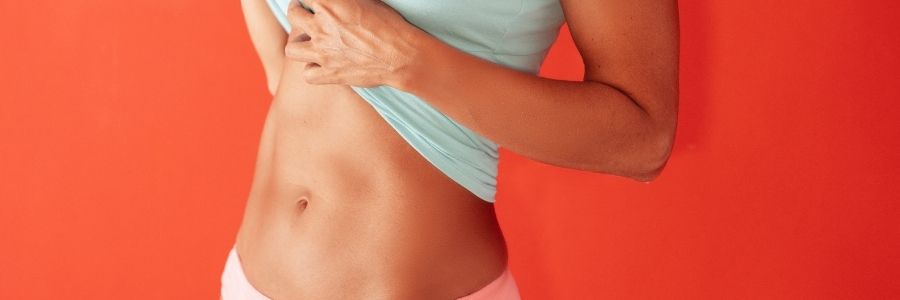A reverse tummy tuck addresses the same body image concerns as a traditional one but in the upper abdominal area. Today we want to answer general questions on reverse abdominoplasty and highlight its advantages.
Significant weight loss and pregnancy are two of many reasons that can leave excess skin, sagging in your abdominal area. Even with a healthy diet and exercise regime, this area does not improve. Sometimes the only way to remedy this is through surgery.
The traditional tummy tuck (abdominoplasty) is what most people are familiar with and is used to correct excess skin in the waistline and below the beltline. But what if your problem area is excess skin and tissue above your belly button? This is where reverse abdominoplasty can come to your rescue and return your youthful shape and flatten your tummy.
What Is Reverse Tummy Tuck?
Reverse abdominoplasty is a surgical procedure that tightens and lifts baggy, saggy skin from the stomach area. The traditional tummy tuck removes skin from the lower stomach, but the reverse abdominoplasty removes skin from just the upper portion. An incision is made in the breast crease – below the breasts where they meet the chest wall – which leaves the scars well hidden. Reverse abdominoplasty can easily be combined with other cosmetic procedures such as breast augmentation using the same incision to achieve optimal results.
Who Is a Candidate for a Reverse Abdominoplasty
Individuals who have sagging skin above their belly button after a dramatic weight loss even after a previous tummy tuck or would like to combine a tummy tuck with a breast augmentation may benefit from the reverse tummy tuck.
Related: 4 Myths About Pregnancy After a Tummy Tuck.
Patients should be in good health, understand the surgical procedure and aftercare requirements, and have a realistic picture of expected results. If you are planning to become pregnant, you may wish to wait until afterward to have reverse abdominoplasty as it will most likely undo the results of the surgery and require a second procedure.
How Is Reverse Abdominoplasty Surgery Performed?
The surgery is performed under general anesthesia but as an outpatient and you can return home the same day. The procedure normally takes between two and four hours to complete.
The surgeon begins with a small incision along the breast crease – the hidden part that is under the breast where it is attached to the chest. Then, the unwanted loose skin along the upper abdomen as well as fatty deposits will be removed and pulled upward until smooth and tight, and sutured in place. Usually, these sutures will dissolve as you heal so you will not have to return and have them removed by a medical professional.
During a reverse tummy tuck, the belly button is not repositioned, which often occurs during a traditional tummy tuck.
Recovering From Reverse Abdominoplasty
Each patient will recover at their own rate but traditionally recovery takes between 1 and 2 weeks. To help reduce swelling and bruising patients will need to wear a special surgical bandage or compression garment.
Most patients experience mild to moderate discomfort for the first week so the surgeon will prescribe pain medications to help make you more comfortable so you can rest and heal.
Bruising, swelling, and tenderness may remain for the first 10-14 days. Most patients feel well enough to return to work after two weeks unless their job is labor-intensive. Strenuous activities, heavy lifting, and exercise should be avoided for 4-6 weeks or until the surgeon give you the all-clear to resume them.
Learn why patients of a drainless tummy tuck recover faster.
After the Reverse Tummy Tuck Surgery
Right after the procedure, patients can see the results of a smoother, tighter abdomen. As the swelling decreases over the following few months, the full benefits of the surgery will be revealed. The entire abdomen will be lifted and tightened revealing a smooth, healthy contour.
There will be a small scar from the surgery that will fade over time and is usually camouflaged well within the breast crease. Maintaining a healthy weight through diet and exercise should keep your new tummy looking flat and fabulous.
Risks Associated With Reverse Tummy Tuck
There are risks involved in any surgery as well as with the use of general anesthesia. Some of the potential risks include infection, hematoma, seroma, bleeding, bruising, scarring, asymmetry, need for revision surgery, etc.
If you are struggling with excess skin and fatty tissue in your abdominal area and would like to see if reverse abdominoplasty is right for you, please do not hesitate to contact us for a personal consultation.
Angelina Postoev, MD, FACS, a triple board certified cosmetic surgeon, and Christopher Ibikunle, MD, FACS, offer reverse tummy tuck for men and women in Buckhead, Lawrenceville, Suwanee, Johns Creek, and the surrounding areas of Atlanta, Georgia.



